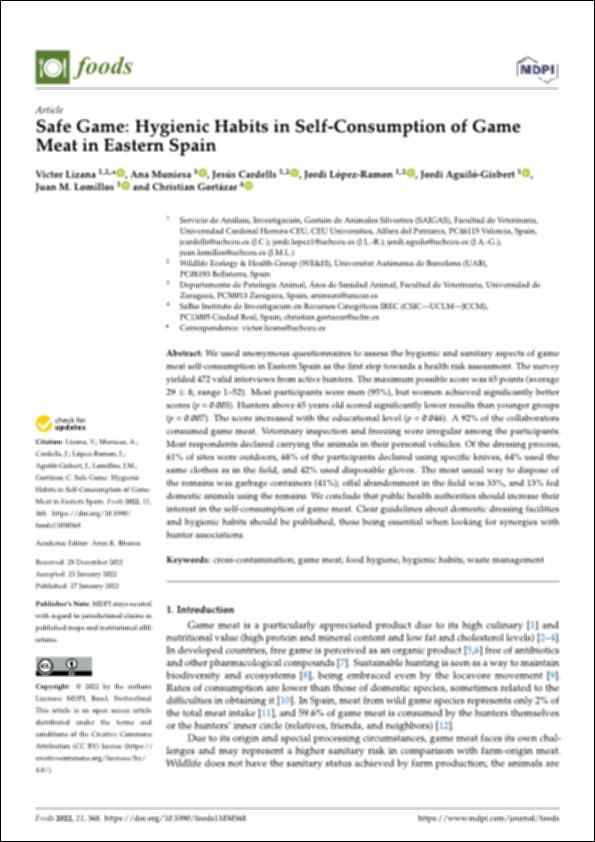Please use this identifier to cite or link to this item:
http://hdl.handle.net/10637/14270Safe game : hygienic habits in self-consumption of game meat in Eastern Spain
| Title: | Safe game : hygienic habits in self-consumption of game meat in Eastern Spain |
| Authors : | Lizana Martín, Víctor Manuel Muniesa del Campo, Ana Cardells Peris, Jesús López Ramon, Jordi Aguiló Gisbert, Jordi Lomillos Pérez, Juan Manuel Gortázar Schmidt, Christian |
| Keywords: | Alimentos - Control de calidad.; Food - Quality.; Food adulteration and inspection.; Food - Security.; Alimentos - Medidas de seguridad.; Meat hygiene.; Carne - Higiene.; Alimentos - Adulteración e inspección. |
| Publisher: | MDPI |
| Citation: | Lizana, V., Muniesa, A., Cardells, J., López-Ramon, J., Aguiló-Gisbert, J., Lomillos, J. M. & Gortázar, C. (2022). Safe game: hygienic habits in self-consumption of game meat in Eastern Spain. Foods, vol. 11, i. 3 (27 jan.), art. 368. DOI: https://doi.org/10.3390/foods11030368 |
| Abstract: | We used anonymous questionnaires to assess the hygienic and sanitary aspects of game meat self-consumption in Eastern Spain as the first step towards a health risk assessment. The survey yielded 472 valid interviews from active hunters. The maximum possible score was 65 points (average 29 8; range 1–52). Most participants were men (95%), but women achieved significantly better scores (p = 0.003). Hunters above 65 years old scored significantly lower results than younger groups (p = 0.007). The score increased with the educational level (p = 0.046). A 92% of the collaborators consumed game meat. Veterinary inspection and freezing were irregular among the participants. Most respondents declared carrying the animals in their personal vehicles. Of the dressing process, 61% of sites were outdoors, 68% of the participants declared using specific knives, 64% used the same clothes as in the field, and 42% used disposable gloves. The most usual way to dispose of the remains was garbage containers (41%); offal abandonment in the field was 33%, and 13% fed domestic animals using the remains. We conclude that public health authorities should increase their interest in the self-consumption of game meat. Clear guidelines about domestic dressing facilities and hygienic habits should be published, these being essential when looking for synergies with hunter associations. |
| Description: | Este artículo se encuentra disponible en la siguiente URL: https://www.mdpi.com/2304-8158/11/3/368 Este artículo de investigación pertenece a la sección "Food Quality and Safety". |
| URI: | http://hdl.handle.net/10637/14270 |
| Rights : | http://creativecommons.org/licenses/by/4.0/deed.es |
| ISSN: | 2304-8158 (Electrónico) |
| Language: | es |
| Issue Date: | 27-Jan-2022 |
| Center : | Universidad Cardenal Herrera-CEU |
| Appears in Collections: | Dpto. Producción y Sanidad Animal, Salud Pública Veterinaria y Ciencia y Tecnología de los Alimentos |
Items in DSpace are protected by copyright, with all rights reserved, unless otherwise indicated.


